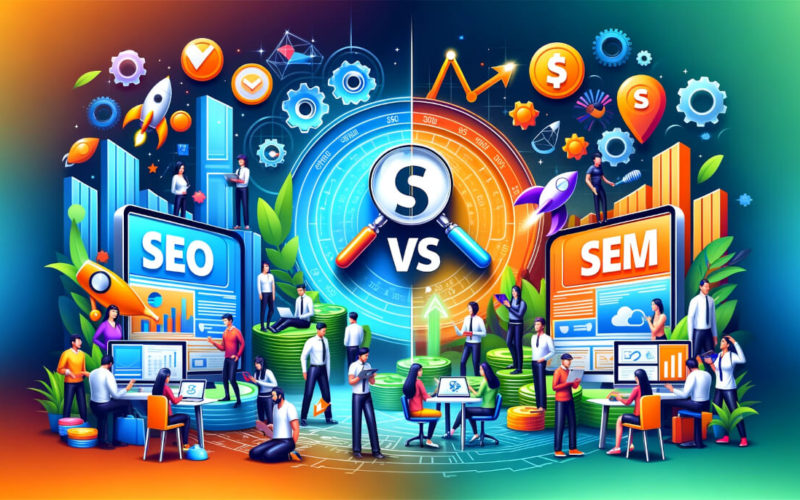
Digital marketing has become a critical component of modern business, enabling companies to engage with consumers more effectively than ever. From optimizing search engines (SEO) to crafting impactful social media strategies, it plays a vital role in connecting brands with their target audience.
As highlighted by the agency Social Shepherd, digital advertising can increase brand awareness among potential customers by an impressive 80%.
To stay ahead in this dynamic field, it’s essential to grasp the fundamentals of digital marketing and develop the skills required to thrive.

A Comprehensive Guide to Digital Marketing
Digital marketing involves the use of strategies and techniques to leverage digital channels, platforms, and technologies to engage with your target audience effectively.
While traditional marketing methods, such as print ads and TV commercials, remain useful, the rise of e-commerce, social media, and mobile technology has significantly transformed consumer behavior.
“These advancements have revolutionized how consumers interact with brands, search for information, and make purchasing decisions,” explains Harvard Business School Professor Sunil Gupta, who leads the online course Digital Marketing Strategy. “This shift is why digital marketing has become a crucial aspect of every business.”
To excel as a digital marketer and drive strategic success, mastering these essential skills is key.

What Are the Top Digital Marketing Skills?
1. Technology Proficiency
Having a solid grasp of technology is vital for success in digital marketing. Executing campaigns effectively requires familiarity with automation tools, software, and digital platforms.
Key digital marketing tools include:
- Customer relationship management (CRM) systems
- Analytics software
- Ad management tools
- Content management systems (CMS)
By leveraging these tools, you can better understand and segment your audience, learn from their behaviors, and identify emerging trends. This enables you to maximize the impact of your marketing efforts.
Anne Lewnes, Chief Marketing Officer at Adobe, emphasizes the importance of technology in understanding customers.
“While marketing fundamentals like a great idea and product remain constant, technology has transformed how deeply we can understand our customers,” Lewnes shares in Digital Marketing Strategy. “This deep understanding is essential for effective marketing.”
2. Data Analysis
Data analysis is a cornerstone of both traditional and digital marketing. It involves systematically collecting, interpreting, and utilizing data to drive decisions.
Channels for data collection include:
- Websites
- Social media platforms
- Email campaigns
However, data only becomes actionable when tied to clear metrics or key performance indicators (KPIs).
“At its core, you need to measure your success based on your marketing objectives,” says Professor Sunil Gupta in Digital Marketing Strategy.
For instance, if brand awareness is your goal, analyze data from social media shares, website mentions, and customer surveys. These insights can help you understand prospective and existing customers better.
3. Search Engine Marketing (SEM)
Advertising plays a pivotal role in succeeding in the digital landscape. Search engine marketing (SEM) focuses on increasing a website’s visibility through paid search engine advertisements.
Professor Gupta highlights SEM as “a critical tool for driving customer conversions.” In Digital Marketing Strategy, SEM is broken into two main types:
- Paid Search Ads: Bidding on keywords to display ads prominently in search engine results and paying a fee for each click.
- Display Ads: Visual advertisements, including banners, images, and videos, shown across websites to engage target audiences.
SEM is particularly effective because it enables precise targeting of consumer needs. Successful SEM campaigns include:
- Selecting the right keywords
- Crafting compelling ad content
- Identifying optimal landing pages
- Developing effective bidding strategies
- Analyzing and optimizing campaign performance
For example, if a traveler searches for “hotel in Boston,” brands like Hilton might bid on those keywords to ensure their website ranks high in search results.
“Investing in generic keywords like ‘hotel in Boston’ increases visibility to a broader audience, including those unfamiliar with your brand,” Gupta explains.
By mastering SEM, you can ensure your ads reach the right audience at the right time, enhancing your overall marketing impact.

4. Search Engine Optimization (SEO)
Another crucial skill in digital marketing is search engine optimization (SEO), which involves enhancing your website’s visibility and ranking in organic search results.
Approximately 68% of online experiences begin with search engines like Google. Unlike SEM, which focuses on paid search ads, SEO improves elements such as content, keywords, meta tags, site structure, and user experience to help your web pages rank higher in search results.
According to Digital Marketing Strategy, search engines evaluate pages based on:
- Relevance: How well the content aligns with the user’s search intent.
- Authority: The credibility of your website, which is influenced by factors like content expertise and brand reputation.
By understanding search engine algorithms and applying SEO best practices, you can increase traffic and visibility without relying heavily on paid ads, resulting in greater user engagement and cost savings.
5. Brand Development
A key challenge for marketers today is engaging consumers on crowded digital platforms. One effective strategy is brand development—managing your company’s identity and reputation across various marketing channels.
However, this can be difficult.
“Digital marketing often focuses more on performance marketing than brand building,” says Professor Gupta in Digital Marketing Strategy. “This shift is happening over time, but traditionally, digital marketing has been about short-term, measurable targets rather than long-term brand development.”
Performance marketing focuses on immediate, measurable actions, such as conversions from a specific ad. On the other hand, brand-building emphasizes long-term consumer relationships and broad brand awareness. This involves crafting a unique brand voice, visual identity, and messaging that resonates with your target audience.
6. Email Marketing
Before the rise of digital marketing, businesses relied heavily on print mail and advertisements. However, email marketing has proven to be a powerful tool. According to research by The Radicati Group, the number of email users is expected to reach nearly 4.5 billion by the end of 2024, with users spending an average of 172 minutes per day checking their email.
Email marketing involves sending personalized, targeted emails to segmented customer groups to build relationships, promote products, and share valuable content.
It’s essential to balance broad email content for new customers with more targeted messaging for existing ones.
“You need to reach a wide audience with your general marketing, but also personalize emails to make them relevant to each consumer’s actions and interests,” says Kate Laliberte, head of e-commerce at OOFOS, in Digital Marketing Strategy.
Personalized emails should include customer names, tailored product recommendations based on past purchases, and exclusive offers aligned with their preferences.
Email marketing is also cost-effective, as it allows you to connect with customers without paying for ads on platforms like Google or Facebook. By mastering email marketing, you can foster customer relationships, drive conversions, and boost engagement.
7. Social Media Marketing
Social media is one of the most widely used digital platforms, with 72% of the U.S. population engaging on various platforms, according to Pew Research. In a world dominated by social influencers, maintaining a digital presence is essential for staying relevant.
Popular social media platforms for businesses include:
While Facebook is the most widely used platform, it’s important to diversify your approach by incorporating other social channels to reach a broader audience and gather more consumer insights.
“Unlike surveys or focus groups, social media provides a free, unfiltered platform where companies can gain insights into consumer behaviors and attitudes,” explains Gupta in Digital Marketing Strategy.
By leveraging social media, businesses can better understand customer preferences and refine their marketing strategies.

How to Enhance Your Digital Marketing Skills
While some marketers can enhance their digital marketing skills through hands-on experience, others may need a more comprehensive approach. If this applies to you, an online course can be a great way to develop your skills while maintaining your professional growth at work.
For example, the Digital Marketing Strategy course is designed to help you create effective digital marketing strategies that attract and retain customers. Through real-world case studies, you’ll learn how to leverage modern digital tools to become a more proficient marketer.
Ready to boost your digital marketing expertise? Explore Digital Marketing Strategy to see how it can help. If you’re new to online learning, download our free guide to online learning success for a helpful starting point.


